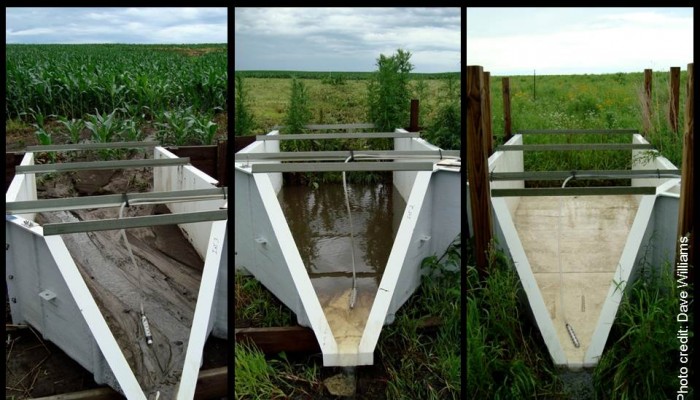
Making room for prairie STRIPs: Lisa Schulte Moore (Land Sharing/Sparing #1)
“I got kind of sick of working on environmental problems, and I wanted to work on environmental solutions. From that standpoint, agriculture — it’s like the world is your oyster. There’s so much that could be done.”
Lisa Schulte Moore, an professor of natural resource ecology and management at Iowa State University, seems to have the energy of three people. She has a hand in agricultural landscape management, bioenergy development, oak restoration, and hemlock and pine forest management, among other projects, and still makes time to drive all over Iowa, talking to farmers. In this episode of Field Talk, she explains how integrating STRIPs of prairie into conventional row crops improves water quality — and helps farms, waterways, and wildlife.
This is the first in a series of conversations springing from ideas and arguments about “land-sparing” and “land-sharing” strategies to conserve a rich tapestry of species in our human dominated world. Should we intensively farm some lands in order to preserve wildness in reserves? Accept a more flexible, less “pure,” idea of wildness, embracing conservation easements threaded into more diversified agricultural landscapes? Is this dichotomy a useful concept at all?

Soil erosion….or not. Even small amounts of perennials can have a dramatic impact on the environmental benefits provided by row-cropped agricultural lands. This image depicts the ability of native prairie to keep soil in farm fields, where it can produce crops, as opposed to allowing it to move into streams, where it becomes a serious pollutant. The STRIPS Project has shown that farm fields with just 10% of their area converted to native prairie produce diverse environmental benefits in amounts greatly disproportionate to their extent compared to fields entirely in row-crop production. This image was taken after a 4 inch rain. Caption, Lisa Schulte Moore. Photo, Dave Williams.
Show notes:
- [0:00] song of the dickcissel (Spiza Americana), recorded by Jonathon Jongsma at Dordt College Prairie, in Sioux, Iowa in July, 2013. Background birds: red-winged blackbird, common yellowthroat, American crow, American robin.
- [3:20] Lisa Schulte Moore’s Lab
- [5:30] “If you’re working in agriculture, it’s going to be all about privately owned landscapes. If you want anything to stick, it’s gotta work for the people that own and manage that private land. It means working with farmers, and the people who talk to farmers.”
- [10:10] farm policy, risk management and unintended consequences: the Energy Independence and Security Act (2007)
- [12:28] the four big water pollutants in Iowa, nitrogen, phosphorus, sediment, and bacterial contamination, cause problems near and far.
- [13:22] Science-based Trials of Rowcrops Integrated with Prairies (STRIPs) at the Neal Smith National Wildlife Refuge
- [14:30] four experimental treatments in the STRIPs pilot project
- [23:30] birds: we can pack in more territories for dickcissels and common yellowthroats when strips are interlaced into the rowcrops than if the same amount of prairie is placed at the base of a field.
- [27:17] stage II: putting STRIPs into working farms (pdf) – an abundance of volunteers
- [31:26] Should agricultural policies encourage land sparing or wildlife-friendly farming? (2008) Joern Fischer, Berry Brosi, Gretchen C Daily, Paul R Ehrlich, Rebecca Goldman, Joshua Goldstein, David B Lindenmayer, Adrian D Manning, Harold A Mooney, Liba Pejchar, Jai Ranganathan, and Heather Tallis. Frontiers in Ecology and the Environment 6:7, 380-385.
- [34:45] “Right now, probably the top concern in the agricultural realm itself is that soil fertility piece. How do we maintain soil quality into the future?” Natural Resources Conservation Service (USDA-NRCS) campaign on soil quality.
- [39:50] “What’s going to work in this place, for this farmer?”
3 replies on “Making room for prairie STRIPs: Lisa Schulte Moore (Land Sharing/Sparing #1)”
Leave a Reply
You must be logged in to post a comment.


Pingback:Making room for prairie STRIPs in Iowa’s cornbelt | EcoTone: news and views on ecological science
Pingback:Why I did a Science Cafe – a guest post by Lisa Schulte Moore | EcoTone: news and views on ecological science
Pingback:A “Sip of Science” in Minnesota | Leopold Leadership 3.0